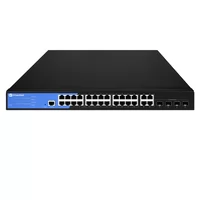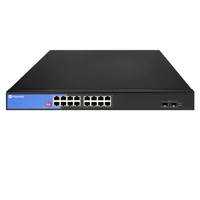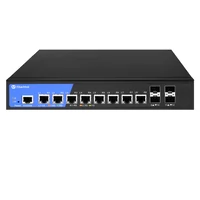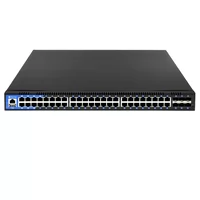The selection of the switch has an enormous bearing on how well the network performs, its speed, and how scalable it is, making it a choice that shouldn’t be taken lightly. Managed and unmanaged switches are the two standard types of switches covering a variety of features and benefits. How do you know which type is more appropriate for your situation? This article outlines and compares the five fundamental aspects distinguishing managed switches from unmanaged ones for easier understanding and later use. Knowing these differences will help you build the proper network, whether fine-tuning a small home network or setting up infrastructure for a large organization.
Table of Contents
ToggleWhat is a Managed Switch?

A managed switch is a sophisticated device within a network system that allows control and customization. It’s the most appropriate for network adepts. Users can set up parameters for monitoring connected devices and traffic on the network. Managed switches can achieve optimized network performance, security, and troubleshooting capabilities, making them perfect for larger or more complex networks. They customarily support VLANs, Quality of Service (QoS) provisions, and remote access for central management of the devices connected to the network.
Features of Managed Switches
- VLAN Support: The creation and control of Virtual Local Area Networks is made possible by Managed switches, which enhance network segmentation and security (VLANs).
- Quality of Service (QoS): With these switches, specific traffic can be prioritized, guaranteeing the performance of essential applications (QoS).
- Advanced Security Features: Port security and Access Control Lists (ACLs) are features available in managed switches that help constrain unauthorized access and attacks, enhancing security.
- Traffic Monitoring: The managed switches enable the administrator to monitor and study the network’s traffic to find and resolve problems as they arise.
- Scalability: Managed switches allow the network to be modified and expanded as business requirements increase, providing the organization with the best value (cost-benefit).
- Remote Management: They enable centralized management via web-based dashboards and command-line interfaces, simplifying the workflow by further supporting remote management (operations).
How Managed Switches Provide Network Control
With managed switches, there is complete control over the network because every detail of network traffic can be configured and monitored precisely. The switches permit admins to control what data is of utmost importance, preset specific bandwidth caps, and form VLANs for better traffic management about both efficiency and security. They ensure optimized performance and swift resolution of network problems using QoS and other techniques, such as port mirroring. Enhanced centralized management tools improve control over complex or more extensive networks. The combined capabilities create a network infrastructure that is reliable, secure, and scalable.
Remote Management Capabilities of Managed Switches
Managed switches have strong remote management functions that let administrators set and manage network configurations from practically every location. These functions normally consist of secure login via webpages, mobile apps, or command line functions like SSH. SNMP (Simple Network Management Protocol) is another feature that facilitates monitoring and diagnosis in real-time. Remote management makes troubleshooting network problems faster and easier, reducing downtime. Furthermore, updates or changes can be made without physical access to the switch, making remote management a vital feature for modern networking.
Understanding Unmanaged Switches

Basic Functions of Unmanaged Switches
Unmanaged networks have switching capabilities that need no configuration or user intervention. They automatically recognize devices on the network and direct packets to the relevant addresses using MAC tables. The switches were designed with ease and dependability in mind, utilizing plug-and-play features that are optimal for lesser networks where traffic control is minimal. Even though these switches do not include VLAN support, remote management capability, or other advanced options, unmanaged switches are an economical alternative for basic connectivity.
Why Choose an Unmanaged Switch?
Due to their photographic affordability, unmanaged switches pose an excellent choice for deployment in simple network configurations. Since no configuration is required, the switches are uncomplicated enough to be used and installed in small businesses, home networks, or any place that does not require advanced features such as traffic prioritization or VLANs. These switches ensure reliable, straightforward connectivity without ongoing management. Unmanaged switches give users a plug-and-play solution that saves time and resources. Unmanaged switches are a reliable and practical solution for basic, cost-effective networking.
How to Decide: Managed vs. Unmanaged Switches

Key Difference Between the Two
The core distinction between managed and unmanaged switches rests on control and customization. Managed switches have advanced features, including network monitoring and traffic prioritization, VLAN setup, and security configurations. These features allow an administrator to optimize and secure their networks. However, unmanaged switches are simple and automatic; they immediately operate upon connection with no configuration required. Managed switches are suited for complex and large-scale networks requiring more details, and unmanaged switches are appropriate for straightforward and low-maintenance networking needs.
When to Use a Managed Switch
Managed switches are handy for advanced user control, scalability, and network security. A good example is managed switch implementations, which allow VLANs (Virtual Local Area Networks) to optimize performance while isolating sensitive data traffic. As they are tailored to high-volume traffic environments, managed switches are best suited for enterprises, data centers, and organizations with diverse, high-demand network demands.
Telecommunication networks with VoIP (Voice over Internet Protocol), video conferencing, and cloud computing can benefit tremendously from other critical functionalities that managed switches offer. Tools for monitoring and troubleshooting a network, or SNMP (Simple Network Management Protocol), improve efficiency as it helps increase operational uptime. With managed switches, administrators can monitor and control management protocols, increasing productivity because features such as Quality of Service (QoS) enable prioritization of real-time services with guaranteed low latency or interruptions.
Most recent managed switch intelligence has shown that businesses, on average, save up to 30% of their budgets on productivity improvements as single-point integration removes infrastructure silos. As shown, these managed switches’ Ports Security and Access Control Lists provide robust advanced configurations that secure the network from unauthorized access and ameliorate malicious activities.
Generally, a managed switch is most suitable for networks requiring scaling, custom setups, or increased security. It enables administrators to mold the network according to changing business requirements while ensuring maximum efficiency and dependability.
Scenarios for Unmanaged Switch Deployment
Unmanaged switches are ideal for small networks that are not complex and do not require much configuration. They are best in home networks, small offices, or short-term configurations requiring simplicity, low cost, flexibility, and autonomy. These switches do not require prior technical knowledge, so they can easily be used by individuals who only need basic internet access. Furthermore, unmanaged switches are great for use when sophisticated network control is unnecessary, such as when using peripherals like printers and cameras.
Exploring PoE Switches

Benefits of a PoE Switch
PoE (Power over Ethernet) switches facilitate easy deployment in all locations since they transmit data and supply electrical power through one Ethernet cable, granting its users a notable benefit. Network installation and deployment of IP cameras, wireless access points, and VoIP phones are made easier because these devices no longer require separate power cables, lowering the overall cost. In addition, these switches improve flexibility by allowing devices to be installed in locations that do not have direct power outlets. Also, better control over the connected devices is granted with facilitated centralized power management, which improves the efficiency of the network. For these reasons, PoE switches are perfect for advanced, scalable networking technology.
Integrating PoE Switch into Your Network
When incorporating an ethernet switch into the network, especially using a PoE switch, the process is direct and maximizes efficiency and connectedness. Initially, choose a PoE switch that fulfills the power and port requirements of the devices. Then, Ethernet cables are plugged into the switch to link it with the leading network and facilitate data flow. Control and cost efficiency in setups can be enhanced by connecting PoE devices like IP cameras or access points directly to the switch’s PoE ports. Overloading the switch should be avoided by ensuring its power capacity meets the demands of all corresponding devices. Finally, the devices should be systematically verified to ensure they receive power and work correctly. Such a setup creates a streamlined network infrastructure, enhancing local networks’ performance.
Enhancing Network Infrastructure with CXtec

Unlock the Value of Managed Switches with CXtec
Unmanaged and managed network switches impact the performance of a network. CXtec guarantees expertly refurbished solutions from one of the most reliable sources. When you choose CXtec, you are provided with managed switches with advanced traffic control, monitoring, and security features. Maximum investment value is delivered through our flexible warranty terms and low-cost extensive testing. Seamless integration and continual assistance to improve your network come from CXtec’s dedicated support team, making it easier to enhance your network confidently.
Lifetime Warranty on Network Switches
Offering a lifetime warranty on network switches helps CXtec customers have peace of mind and ensure value over the long term. The warranty covers all costs for repairs or replacements in case of failure, protecting their investment and enhancing productivity due to less downtime. Offering a lifetime warranty demonstrates our utmost commitment to quality and reliability, giving customers peace of mind regarding the network equipment. For more information, our support team is available to answer any questions regarding the warranty or assist with claims.
Frequently Asked Questions (FAQs)
Q: What is the difference between a managed and unmanaged switch?
A: Managed switches allow network administrators to configure and monitor settings such as VLANs and QoS, while unmanaged switches have more straightforward features but do not permit configuration and monitoring.
Q: What advanced features improve network performance on managed switches?
A: The spanning tree protocols, QoS, and VLAN features on managed switches help optimize network traffic and congestion and facilitate efficient segmentation, which improves performance.
Q: Are unmanaged switches appropriate for large networks?
A: Unmanaged switches can be used in large networks but are not recommended. Managed switches are highly configurable, making them suitable for large-scale network configuration.
Q: How is VLAN support implemented on managed switches, and why is it important?
A: VLAN support in managed switches improves security and network topology organization and reduces broadcast traffic by creating separate network segments within the same physical network.
Q: Can we consider smart-managed switches a mid-point compromise between unmanaged and managed switches?
A: Smart Managed switches, also known as Easy Smart Managed Switches, provide a certain degree of control and management at a price level below fully managed switches. As a result, they can be considered a viable option for more minor to mid-sized networks that require greater control than unmanaged switches can provide.
Q: Why are switches deemed a fundamental component of the network architecture?
A: Switches are significant in network configuration because they can link devices on the network and allow communication among them, control data traffic, and provide sophisticated features such as VLANs, QoS, and Network Segmentation, which are paramount for a strong and efficient network.
Q: In the context of managed and unmanaged switches, how does Cisco compare to Netgear?
A: Cisco and Netgear have a selection of managed and unmanaged switches. However, Cisco is known for its enterprise-grade solutions, rich feature sets, and reliability. At the same time, Netgear focuses on more competitively priced, easy-to-use switches aimed at small and medium enterprises.
Q: What aspects of managed switches are absent in unmanaged switches?
A: Unmanaged switches lack the VLAN configuration, QoS prioritization, link aggregation, and network monitoring features of managed switches. For this reason, managed switches are more appropriate for complex and high-demand networks.
Q: What is the advantage of having SFP ports on managed switches?
A: Managed switches with SFP ports can use fiber optic cables extending further than copper cables, enabling quicker data transfer and aiding network growth. This is especially advantageous for large and inter-building networks.
Reference Sources
1. Managed Switch for Digital and Analog Signals
- Authors: S.V. Hakhovych, G. Zhyrov
- Published in: Collection of scientific works of the Military Institute of Kyiv National Taras Shevchenko University
- Publication Year: 2023
- Citation: (Hakhovych & Zhyrov, 2023)
- Summary:
- This paper analyzes the gap in the diagnostic systems of complex radio-technical objects utilized by the Armed Forces of Ukraine with special reference to the 19Ж6 radar station. The authors proposed a managed switch’s structural diagram that accommodates digital and analog signals. The application of this switch within the automated diagnostic complex (ADC) of the ‘Diana’ series is expected to improve the automation of the diagnostic process, make the connection of diagnostic objects more manageable, and shorten the time spent on diagnostics, thus improving the readiness coefficient of radio-electronic weaponry (REW) velocity.
- Methodology: The research focuses on designing a managed switch and proposing its functional parts for military diagnostics automation.
2. Managed Switch Interconnected Energy Efficient Clusters
- Authors: Ikeda Yoshiro, Yasuo Akihiro, Mori Atsushi, Nishikawa Katsuhiko, Asato Akira
- Published in: Data not provided (Conference paper)
- Publication Year: 2005
- Citation: (Yoshiro et al. 2005, pp. 7–12)
- Summary:
- This paper focuses on managed switches used in cluster interconnects and their related aspects. While not from the last five years, it was a guiding reference for using managed switches to increase energy efficiency in network interconnections.
- Methodology: the authors design and analyze several configurations and their effect on energy use, although the summary does not provide details of the actual experiments undertaken.
Related Products:
-
 S2100-24T4TS, 24-Port Ethernet Switch L2+, 24x 10/100/1000BASE-T RJ45, with 4x 1G RJ45/SFP Combo Uplinks
$148.00
S2100-24T4TS, 24-Port Ethernet Switch L2+, 24x 10/100/1000BASE-T RJ45, with 4x 1G RJ45/SFP Combo Uplinks
$148.00
-
 S2100-16T2S-P, 16-Port Ethernet Switch L2+, PoE+ Switch, 16x 10/100/1000BASE-T RJ45, with 2x 1G SFP Uplinks
$230.00
S2100-16T2S-P, 16-Port Ethernet Switch L2+, PoE+ Switch, 16x 10/100/1000BASE-T RJ45, with 2x 1G SFP Uplinks
$230.00
-
 S3100-8T4X, 8-Port Ethernet Switch L3, 8x 10/100/1000/2500/10G BASE-T RJ45 Ports, with 4x 1G/10G SFP+ Uplinks
$398.00
S3100-8T4X, 8-Port Ethernet Switch L3, 8x 10/100/1000/2500/10G BASE-T RJ45 Ports, with 4x 1G/10G SFP+ Uplinks
$398.00
-
 S3100-48T6X-P, 48-Port Ethernet Switch L3, PoE+ Switch, 48x 10/100/1000BASE-T RJ45, with 6x 1G/10G SFP+ Uplinks
$734.00
S3100-48T6X-P, 48-Port Ethernet Switch L3, PoE+ Switch, 48x 10/100/1000BASE-T RJ45, with 6x 1G/10G SFP+ Uplinks
$734.00




